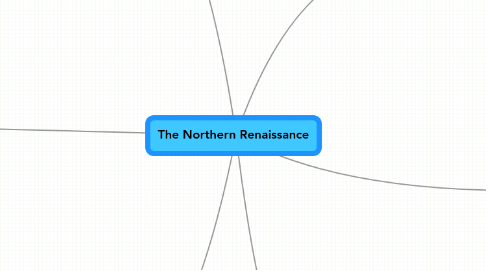
1. The Northern Renaissance Begins
1.1. As Renaissance ideas spread out of Italy, they mingled with northern traditions.
1.1.1. And they developed their own character in northern Renaissance.
1.2. Italy was divided into city-states where as England and France were unified under strong monarchs.
1.3. The weath increased in other parts of northern Europe.
1.3.1. Then the money for the artists increased as well.
1.4. The population of norther Europe, which was down because of the bubonic plague, was now steadily beginning to increase.
1.4.1. Many Cities began to grow rapidly.
2. The Elizabethan Age
2.1. This was named after Queen Elizabeth I.
2.1.1. She was educated and spoke French, Italian, Latin, and Greek.
2.1.2. She also wrote poetry and music.
2.2. William Shakespeare
2.2.1. He is one of the most famous writers of all time.
2.2.2. He drew on his personal life for inpiration and plots.
2.2.3. His works display a masterful command of the English language and a deep understanding of human beings.
2.2.4. His most famous works were Macbeth, Othello, Hamlet, Romeo and Juliet, King Lear, and The Tamin of the Shrews.
3. The Legacy of the Renaissance
3.1. Changes in the Arts
3.1.1. Art drew on techniques and styles of classical Greece and Rome.
3.1.2. Paintings and sculptures portrayed individuals and nature in a more realistic and lifelike ways.
3.1.3. Artists created works that were secular as well as those that were religous.
3.1.4. Writers began to use venacular languages to express their ideas.
3.1.5. The arts praised individual achievement.
3.2. Changes in Society
3.2.1. Printing changed society by making more information available and inexpensive enough for society at large.
3.2.2. A greater availabilty of books prompted an increase desire of learning and a rise in literacy throughout Europe.
3.2.3. Published accounts of new discoveries, maps, and charts led to further discpveries in a variety of fields.
3.2.4. Published legal proceedings made the laws clear so that people were more likely to understand their rights.
3.2.5. Christian humanists attemps to reform society changed veiws about how life should be lived.
3.2.6. People began to question poitical structures and religious practices.
4. Artistic Ideas Spread
4.1. They got new techniques into Northern European states.
4.2. German Painters
4.2.1. The most famous Albrechy Durer.
4.2.1.1. He traveled to Italy to study in 1494.
4.2.1.2. Many of his things were woodcuts and engravings.
4.2.1.3. He was a realist abd his portraits are almost photographic in detail.
4.2.1.4. He also painted the royal family.
4.3. Flemish Painters
4.3.1. The most famous was Van Eyck.
4.3.1.1. He developed the oil-based painting method that is still used today.
4.3.1.2. He also did the everyday life of peasants such as weddings, dances, and harvests.
5. Northern Writers Try to Reform Society
5.1. Italian humanists were very interested in reviving the classical languages and classical texts.
5.2. Christian Humanists
5.2.1. Desiderius Erasmus was most famous for his work he wrote The Praise of Folly.
5.2.1.1. This book poked fun at greedy mechants, heartsick lovers, quarrelsome scholars, and pompous priests.
5.3. Women's Reforms
5.3.1. Christine de Pizan spoke out about the practice of women not being aloud to do anything.
5.3.1.1. She was highly educated and was one of the first women to earn a living as a writer.
5.3.1.2. She wrote short stories, biographies, novels, and manuals on military techniques.
6. Printing Spreads Renaissance Ideas
6.1. The Chinese invented block printing, in which a printer carved words or letters on a wooden block, inked the block, and used it to print on paper.
6.1.1. Chinese writing has thousands of characteristics.
6.2. Gutenberg Improves the Printing Process.
6.2.1. He was a craftsman and developed a printing press that incorporated a number of technologies in a new way.
6.2.1.1. The process made it quicker and easier to produce books.
6.2.1.1.1. And Cheaper.
6.2.2. It enables a printer to produce hundreds of copies of a single work.
